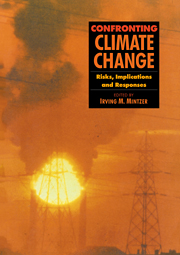Book contents
- Frontmatter
- Contents
- Foreword
- Acknowledgements
- List of Reviewers
- 1 Living in a Warming World
- I The Science of Climate Change
- II Impacts of Global Climate Change
- 7 Future Sea Level Rise: Environmental and Socio-Political Considerations
- 8 Effects of Climate Change on Food Production
- 9 Effects of Climate Change on Shared Fresh Water Resources
- 10 Effects of Climate Change on Weather-Related Disasters
- 11 The Effect of Changing Climate on Population
- III Energy Use and Technology
- IV Economics and the Role of Institutions
- V Equity Considerations and Future Negotiations
- Annex I
- Annex II
- Glossary
- Index
11 - The Effect of Changing Climate on Population
Published online by Cambridge University Press: 06 January 2010
- Frontmatter
- Contents
- Foreword
- Acknowledgements
- List of Reviewers
- 1 Living in a Warming World
- I The Science of Climate Change
- II Impacts of Global Climate Change
- 7 Future Sea Level Rise: Environmental and Socio-Political Considerations
- 8 Effects of Climate Change on Food Production
- 9 Effects of Climate Change on Shared Fresh Water Resources
- 10 Effects of Climate Change on Weather-Related Disasters
- 11 The Effect of Changing Climate on Population
- III Energy Use and Technology
- IV Economics and the Role of Institutions
- V Equity Considerations and Future Negotiations
- Annex I
- Annex II
- Glossary
- Index
Summary
Editor's Introduction
The world's population is growing and will continue to grow in the decades ahead. It took human beings almost 2 billion years of evolution to achieve a population of 5 billion people. If current trends continue, global population will reach at least twice that level within the next century.
Nathan Keyfitz notes that in the past, most population growth has occurred in regions where climate and ecology could support the increased needs of a growing human community. In many cases, especially in societies where agriculture was the main industry, population growth was limited by soil fertility. As manufacturing and trade have become more prominent, the connection between soil quality and population size has become less important. Still, for countries in which more than half the population is engaged in agriculture, rapid climate change could significantly affect the ability to support a growing population. For these countries, a shift in climate, even without a diminution of rainfall, could cause great hardship. But for countries, such as Bangladesh, with high rates of population growth, the difficulties that arise from climate change may pale in comparison to the challenges of managing economic development for a growing population.
As we have seen in previous chapters, the effects of climate change will not be evenly distributed. The Keyfitz analysis suggests that the poor, both among countries and within countries, will be most severely affected by climate change. For example, to the extent that global warming causes agricultural zones to shift, it will increase migratory pressures on the rural poor.
- Type
- Chapter
- Information
- Confronting Climate ChangeRisks, Implications and Responses, pp. 153 - 162Publisher: Cambridge University PressPrint publication year: 1992
- 1
- Cited by

